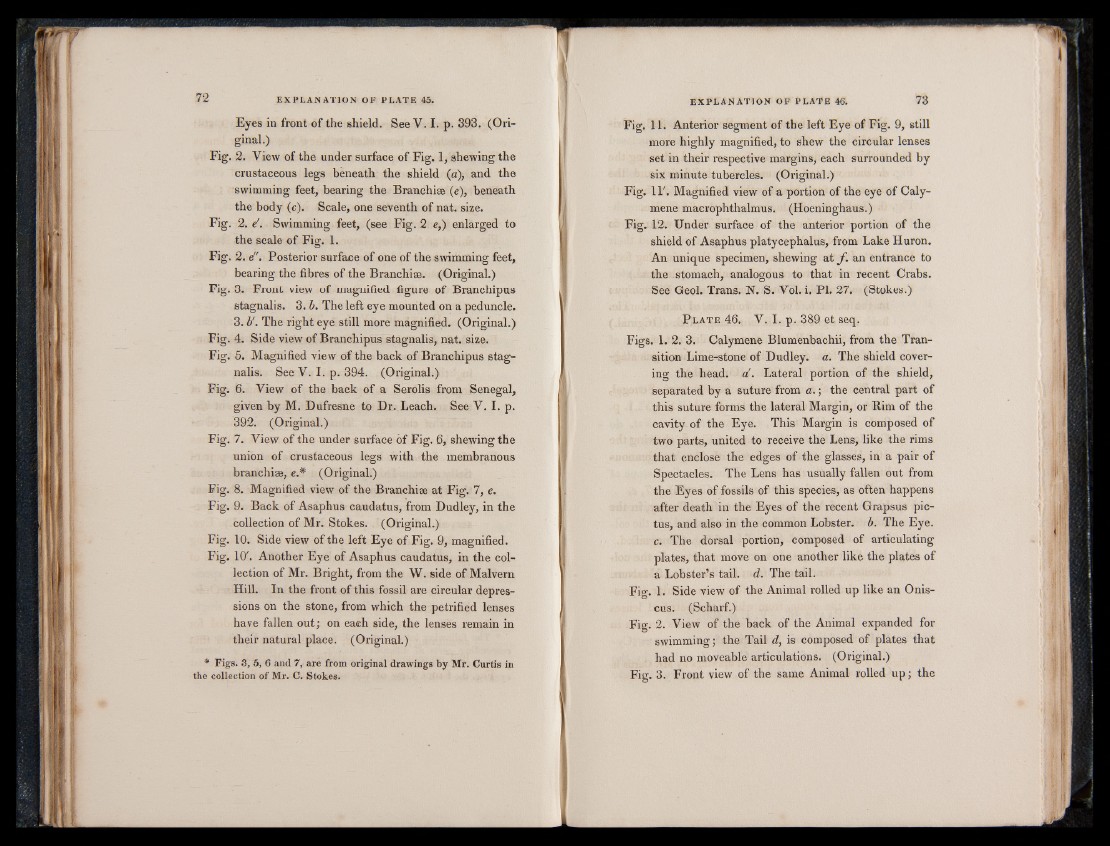
Eyes in front of the shield. See V. I. p. 393. (Original.)
Fig. 2. View of the under surface of Fig. 1, shewing the
crustaceous legs beneath the shield (a), and the
swimming feet, bearing the Branchiae (e), beneath
the body (c). Scale, one seventh of nat. size.
Fig. 2. e'. Swimming feet, (see Fig. 2 e,) enlarged to
the scale of Fig. 1.
Fig. 2. e". Posterior surface of one of the swimming feet,
bearing the fibres of the Branchiae. (Original.)
Fig. 3. Front view of magnified figure of Branchipus
stagnalis. 3. b. The left eye mounted on a peduncle.
3. V. The right eye still more magnified. (Original.)
Fig. 4. Side view of Branchipus stagnalis, nat. size.
Fig. 5. Magnified view of the back of Branchipus stagnalis.
See Y. I. p. 394. (Original.)
Fig. 6. View of the back of a Serolis from Senegal,
given by M. Dufresne to Dr. Leach. See V. I. p.
392. (Original.)
Fig. 7. View of the under surface of Fig. 6, shewing the
union of crustaceous legs with the membranous
branchiae, e.* (Original.)
Fig. 8. Magnified view of the Branchiae at Fig. 7, e.
Fig. 9. Back of Asaphus caudatus, from Dudley, in the
collection of Mr. Stokes. (Original.)
Fig. 10. Side view of the left Eye of Fig. 9, magnified.
Fig. 10'. Another Eye of Asaphus caudatus, in the collection
of Mr. Bright, from the W. side of Malvern
Hill. In the front of this fossil are circular depressions
on the stone, from which the petrified lenses
have fallen out; on each side, the lenses remain in
their natural place. (Original.)
* Figs. 3, 6, 6 and 7, are from original drawings by Mr. Curtis in
the collection of Mr. C. Stokes.
Fig. 11. Anterior segment of the left Eye of Fig. 9, still
more highly magnified, to shew the circular lenses
set in their respective margins, each surrounded by
six minute tubercles. (Original.)
Fig. 11'. Magnified view of a portion of the eye of Caly-
mene macrophthalmus. (Hoeninghaus.)
Fig. 12. Under surface of the anterior portion of the
shield of Asaphus platycephalus, from Lake Huron.
An unique specimen, shewing at ƒ. an entrance to
the stomach, analogous to that in recent Crabs.
See Geol. Trans. N. S. Vol. i. PI. 27. (Stokes.)
P late 46. V. I. p. 389 et seq.
Figs. 1, 2. 3. Calymene Blumenbachii, from the Transition
Lime-stone of Dudley, a. The shield covering
the head. a'. Lateral portion of the shield,
separated by a suture from a. ; the central part of
this suture forms the lateral Margin, or Rim of the
cavity of the Eye. This Margin is composed of
two parts, united to receive the Lens, like the rims
that enclose the edges of the glasses, in a pair of
Spectacles. The Lens has usually fallen out from
the Eyes of fossils of this species, as often happens
after death in the Eyes of the recent Grapsus pic-
tus, and also in the common Lobster, b. The Eye.
c. The dorsal portion, composed of articulating
plates, that move on one another like the plates of
a Lobster’s tail. d. The tail.
Fig. 1. Side view of the Animal rolled up like an Onis-
cus. (Scharf.)
Fig. 2. View of the back of the Animal expanded for
swimming; the Tail d, is composed of plates that
had no moveable articulations. (Original.)
Fig. 3. Front view of the same Animal rolled u p ; the